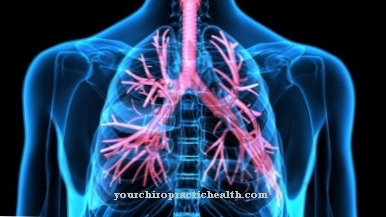At the Wallenberg syndrome the vertebral artery or the inferior posterior cerebellar artery close. The disease is also synonymous as Wallenberg-Foix Syndrome or Viesseaux-Wallenberg designated. As a result, an infarction occurs in a specific area of the brainstem called the dorsolateral medulla oblongata. Basically, it is a rare type of stroke.
What is Wallenberg Syndrome?
In principle this represents Wallenberg syndrome a brainstem syndrome, which is specifically a so-called alternans syndrome. Wallenberg syndrome has a wide range of symptoms that depend on the neurological areas that are affected.
Wallenberg Syndrome was first mentioned in 1808 by Gaspard Vieusseux. However, it got its name after the doctor Adolf Wallenberg. He first described Wallenberg syndrome in 1895. In 1901 the first diagnosis of the disease was made by autopsy.
causes
The primary cause of the development of Wallenberg syndrome is primarily ischemia, which affects the flow area of the vertebral artery. As a result, the posterior inferior cerebellar artery closes. In addition, the dorsolateral medulla oblongata and certain areas of the cerebellum are infarcted.
This damages special pathways in the spinal cord. Certain core areas, for example those of the statoacusticus nerve and the vagus nerve, are also affected. In addition to occlusion of the arteries, there may be severe narrowing of the blood vessels. The branches of the respective arteries may also be affected.
Some of these branches are responsible for supplying the medulla oblongata. The result is an infarction of the lateral elongated marrow. This shows characteristic failure phenomena. In the majority of cases, the vertebral artery is generally affected by Wallenberg's syndrome.
Symptoms, ailments & signs
Wallenberg syndrome has numerous characteristic symptoms. Often there are ipsilateral signs, for example a decreased corneal reflex, disorders of the sensitivity in the face or paralysis of the vocal cords. In addition, Horner's syndrome, hemiataxia and paresis of the soft palate are possible.
In addition, in some cases, dissociated disorders occur in relation to the perception of pain and temperature. However, these symptoms only show up on the body and not on the face. Some patients have a tendency to fall towards the affected side and complain of ipsilateral nystagmus.
If the nucleus spinalis nervi trigemini is impaired, the sensation of pain on the ipsilateral half of the face is lost. The corneal reflex is greatly reduced or completely absent. If the spinothalamic tract is damaged, there is no perception of temperature or pain on the half of the body facing the infarct.
Lesions of the cerebellum or the lower limb of the cerebellum usually result in ataxia. If the hypothalamospinal fibers are damaged, the sympathetic transmission of signals is impaired. As a result, what is known as Horner's syndrome may occur.
If the Nucleus Deiter is affected, dizziness and eye tremors occur. Other possible symptoms of Wallenberg syndrome are hoarseness, hemiataxia, dysarthria, and hypacusis. Trigeminal disorders are also possible.
Diagnosis & course of disease
In order to establish the diagnosis of Wallenberg syndrome, the anamnesis takes place in the first part of the examination. The attending physician discusses the patient's medical history with the sick patient. In the course of this, genetic stress, certain pre-existing conditions, chronic diseases and the personal lifestyle of the person are analyzed.
The anamnesis gives the doctor initial indications for the diagnosis. Various clinical examinations are then carried out. In particular, the typical symptoms of Wallenberg syndrome are clarified. If the affected patient suffers from several characteristic complaints, the suspicion of the presence of Wallenberg syndrome is reinforced.
The prognosis for Wallenberg syndrome is highly dependent on the location and size of the area damaged by the stroke. With recanalization, the symptoms of Wallenberg syndrome subside in some of the patients after a few weeks to months. In the majority of the sick people, however, neurological complaints and functional disorders are still evident after several years.
Complications
Wallenberg syndrome is a serious complaint that can lead to severe complications and restrictions in everyday life for those affected. The patients suffer from an infarction in the brain, causing sensory disturbances or paralysis in the face of the person concerned. This can also lead to swallowing difficulties, so that the patients can no longer easily take food and fluids and are therefore dependent on the help of other people in their everyday lives.
A false sensitivity to temperature and pain can also set in with Wallenberg syndrome, so that those affected may not be able to correctly recognize the dangers. Speech can also be negatively influenced by the syndrome, which can lead to severe difficulties, especially in children. The patients often suffer from trembling eyes or from permanent hoarseness. The quality of life of the person affected is significantly restricted and reduced by Wallenberg syndrome.
Treatment of Wallenberg syndrome is always based on the symptoms, as no causal treatment is possible. There are no particular complications, and complete healing cannot be achieved. The syndrome often has a very negative effect on the quality of life of the person concerned and can promote psychological complaints or even depression.
When should you go to the doctor?
Since the Wallenberg syndrome cannot heal on its own, the person affected with this disease is definitely dependent on a visit to a doctor. Only through early detection and treatment of this syndrome can further complications and complaints be prevented. Early detection always has a very positive effect on the further course of the disease. First and foremost, spells of dizziness indicate the disease. Those affected can no longer concentrate properly and also suffer from significant confusion. There may also be tremors in the eyes or severe hoarseness, which can indicate Wallenberg syndrome.
The perception of temperature changes significantly and pain occurs in different parts of the body. If these symptoms occur for no particular reason and do not go away on their own, you must definitely consult a doctor. In an emergency, an emergency doctor can be called or a hospital can be visited directly. The first diagnosis can be made by a general practitioner. It cannot be universally predicted whether the Wallenberg syndrome will lead to a reduced life expectancy for those affected.
Treatment & Therapy
In principle, the treatment of Wallenberg syndrome is exclusively symptomatic. In some cases, if you have difficulty swallowing, a nasogastric tube is required. Speech therapy may also be prescribed to relieve discomfort when swallowing and speaking.
Medicines are sometimes used to reduce pain. In this case, gabapentin is suitable for the treatment of chronic pain. Since the affected arteries are usually too small, surgical recanalization is usually not possible.
In the long term, it is necessary to prevent further strokes. The corresponding measures are primarily based on the individual risk factors. Aspirin therapy, for example, is used to reduce the risk of another stroke.
Anticoagulants are necessary for atrial fibrillation. In some cases, other drugs are used, such as drugs used to treat high blood pressure. In addition, changing lifestyle is helpful for some of the patients.
prevention
Statements regarding the prevention of Wallenberg syndrome are only possible to a limited extent. Because the disease cannot be prevented in every case. However, certain lifestyle factors play a role in the development of the disease. The health of the blood vessels and the cardiovascular system is of particular importance here.
Aftercare
In most cases, the options for follow-up care for Wallenberg syndrome are significantly limited and are often not available to the person affected. Therefore, the person affected with this disease should consult a doctor as early as possible and initiate treatment in order to prevent the occurrence of other complaints and complications. As a rule, self-healing cannot occur.
Since Wallenberg syndrome is also a genetic disease, it can be inherited, so that if you want to have children, genetic testing and counseling should primarily be carried out to prevent it from occurring again. As a rule, those affected with this disease are dependent on the measures of physiotherapy and physiotherapy to alleviate the symptoms.
The help and support of one's own family in everyday life is also very important, as this can also prevent depression and other psychological upsets. In many cases, contact with other people affected by the disease also proves to be very useful in order to find out how everyday life with the disease can be managed more easily. A general course of Wallenberg syndrome cannot be predicted.
You can do that yourself
The Wallenberg syndrome requires individual therapy, which depends on the symptoms of the stroke. Speech therapy or swallowing therapy, for example, may be necessary to relearn lost skills. These therapies can be supported at home through independent practice.
The use of drugs such as gabapentin must be carefully monitored and recorded due to possible side effects. In addition, general measures must be taken to reduce the risk of stroke. People who suffer from Wallenberg syndrome need to do enough exercise, eat healthily and avoid stress. Depending on the size and location of the damaged area, the symptoms may have subsided after weeks or months.
Usually, however, the sick need permanent support in everyday life. It is the responsibility of the relatives to support the patient as much as possible. Because a stroke usually also causes emotional problems, those affected should seek therapeutic support. Appropriate measures are visiting a self-help group or participating in an internet forum for people affected. By studying specialist reading, the background of Wallenberg syndrome is broken down and the disease can be better understood and accepted.













.jpg)

.jpg)
.jpg)











.jpg)